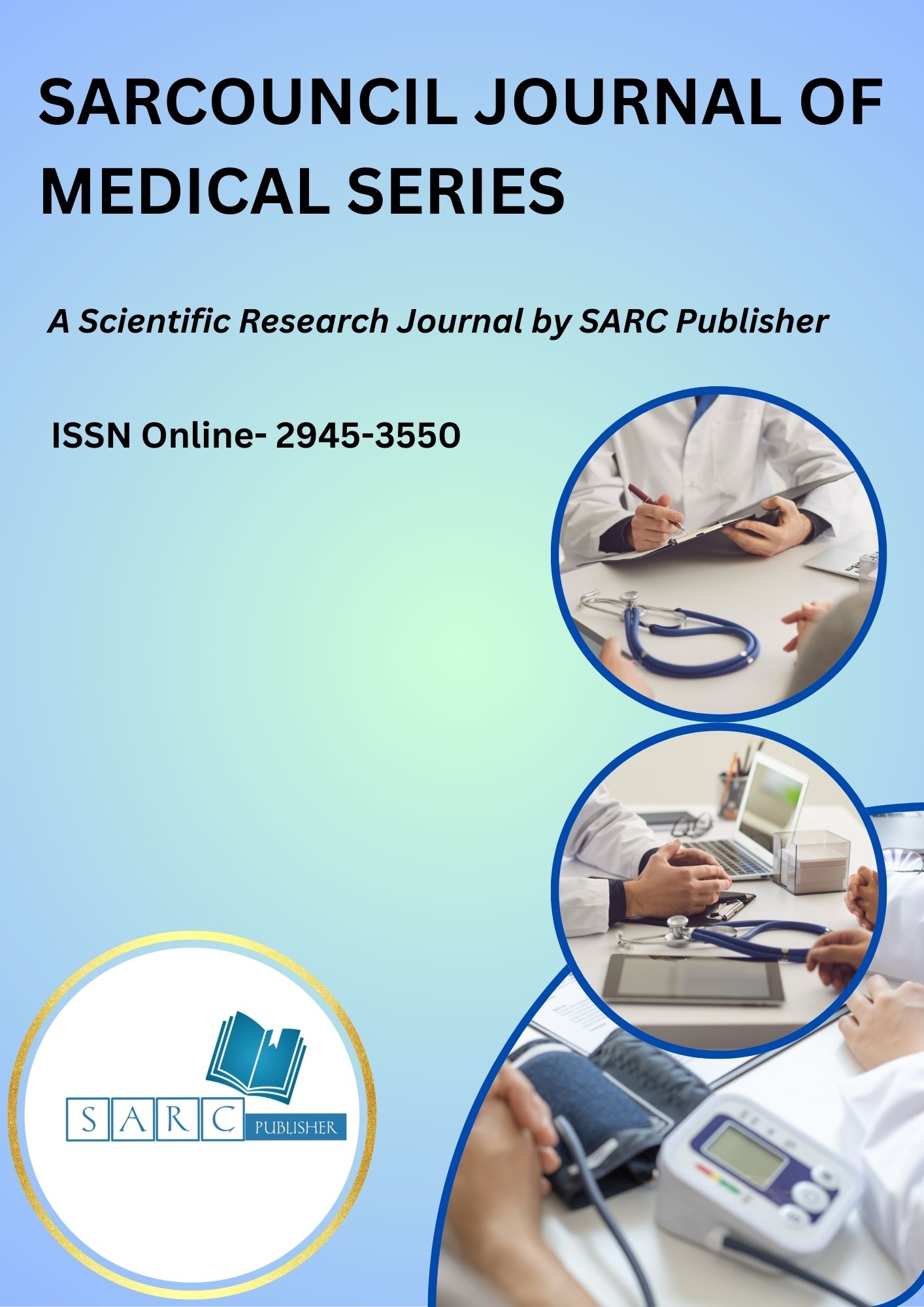Sarcouncil Journal of Medical Series

Sarcouncil Journal of Medical Series
An Open access peer reviewed international Journal
Publication Frequency- Monthly
Publisher Name-SARC Publisher
ISSN Online- 2945-3550
Country of origin- PHILIPPINES
Impact Factor- 3.7
Language- English
Keywords
- Pathology, Radiology, Serology, Surgery, Biochemistry, Biophysics, Cytology, Embryology, Endocrinology, Epidemiology, Genetics, Histology
Editors

Dr Hazim Abdul-Rahman
Associate Editor
Sarcouncil Journal of Applied Sciences

Entessar Al Jbawi
Associate Editor
Sarcouncil Journal of Multidisciplinary

Rishabh Rajesh Shanbhag
Associate Editor
Sarcouncil Journal of Engineering and Computer Sciences

Dr Md. Rezowan ur Rahman
Associate Editor
Sarcouncil Journal of Biomedical Sciences

Dr Ifeoma Christy
Associate Editor
Sarcouncil Journal of Entrepreneurship And Business Management
Latency between the Onset of COVID-19 and Onset of Neurological Disease is not a Reliable Outcome Predictor of the Latter
Keywords: SARS-CoV-2, infection, Guillain-Barre syndrome, opsoclonus myoclonus ataxia syndrome, Miller-Fisher syndrome
Abstract: We read with interest the article by Olbert, et al., on a retrospective, single-centre study in 7 patients with Guillain-Barre syndrome (GBS), two patients with Miller-Fisher syndrome (MFS), and three patients with opsoclonus myoclonus ataxia syndrome (OMAS) during or after a SARS-CoV-2 infection [Olbert, E. et al., 2023]. It was concluded that the outcome in all patients was better when the latency between SARS-CoV-2 detection and the onset of neurological impairment was short, and that pathophysiology may vary depending on this latency [Olbert, E. et al., 2023]. The study is excellent but has some limitations that should be discussed. There is a discrepancy between the methods part and the results part [Olbert, E. et al., 2023]. The methods part states that no patients were excluded, but the results part mentions that 105 patients were screened and only 12 were included [Olbert, E. et al., 2023]. This discrepancy should be clarified. We should also know the criteria used to exclude 93 patients or why the 12 reported patients were selected for inclusion. No mention is made of the criteria used to diagnose GBS [Olbert, E. et al., 2023]. Were the Brighton criteria or other diagnostic criteria used? One of the seven GBS patients was initially diagnosed with chronic inflammatory demyelinating polyneuropathy (CIDP) [Olbert, E. et al., 2023]. Were the EFNS or other criteria used to diagnose CIDP? Why did the patient not receive IVIG after reclassification to GBS? The results of the nerve conduction studies (NCSs) in the seven GBS patients are not mentioned [Olbert, E. et al., 2023]. We should know if all patients had classic acute inflammatory demyelinating polyneuropathy (AIDP) or if some of the patients were also diagnosed with the axonal subtypes acute, motor, axonal neuropathy (AMAN) or acute, motor and sensory axonal neuropathy (AMSAN). We disagree with the conclusion that pathophysiology of neurological diseases varies depending on the latency between the first SARS-CoV-2 positivity and the onset of neurological disease [Olbert, E. et al., 2023]. The design and results of the study do not allow such a conclusion. This was an observational study and no studies of the underlying pathology of the neurological disease conducted. We also disagree with the conclusion that the shorter the latency between PCR positivity and the onset of neurological disease, the better the outcome [Olbert, E. et al., 2023]. Such general conclusions cannot be drawn from two MFS and three OMAS patients. We also disagree with the statement that the interval between SARS-CoV-2 positivity and the occurrence of neurological symptoms varied between 9 and 23 days in the literature [Olbert, E. et al., 2023]. There are a number of GBS/MFS patients with a significantly shorter or longer latency between infection and the onset of the neurological disease [Aladawi, M. et al., 2022]. As for the two patients requiring mechanical ventilation, we should know if the respiratory failure was due to SARS-CoV-2 pneumonia, respiratory muscle involvement in GBS, or due to both. How did the authors distinguish between respiratory failure due to COVID-19 and respiratory failure due to GBS? It is reported that brain imaging was performed in all patients [Olbert, E. et al., 2023]. Was the MRI/CT of the brain performed with or without contrast medium and was an MRA or MRV also performed? SARS-CoV-2 related immune encephalitis can usually only be confirmed by an enhancing cerebral lesion. Contrast-enhanced MRI often shows spinal nerve root enhancement in GBS patients. Was the diagnosis of GBS confirmed by such a radiological examination? The cell counts in the cerebrospinal fluid (CSF) were between zero and 120 cells/mm3 [Olbert, E. et al., 2023]. We should know how many of the 12 patients had pleocytosis and whether patients with GBS or MFS also had elevated leukocytes in CSF? Of the three OMAS patients, one had only tremor and ataxia [Olbert, E. et al., 2023]. The combination of tremor and ataxia could have many other causes [Diezma-Martín, A. M. et al., 2020]. Why was OMAS specifically diagnosed and not another hyperkinetic movement disorder? It is not reported whether both or just one MFS patient was positive for GQ1b. Positivity for GQ1b is pathognomonic for MFS. The observation period was given as 1/20 to 12/22 [Olbert, E. et al., 2023]. Was there already a PCR for the diagnosis of SARS-CoV-2 in 1/20? According to statistics, the first case of COVID-19 was diagnosed in Austria on the 25th February 2020 [www.zeit.de]. According to the methods, patients with a “recent” SARS-CoV-2 infection were screened or included. We should know the definition of “recent”. Overall, the interesting study has limitations that put the results and their interpretation into perspective. Addressing these issues would strengthen the conclusions and could improve the status of the study
Author
- Fulvio A Scorza
- MD Disciplina de Neurociência. Universidade Federal de São Paulo/Escola Paulista de Medicina (UNIFESP/EPM). São Paulo; Brazil
- Josef Finsterer
- MD; PhD; Neurology & Neurophysiology Center; Vienna; Austria.

